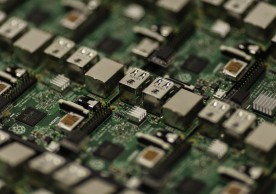
The only obstacle to the success of the IoT (the internet of things) has been security and capacity. But now there's 5G with its reduced latency, a high data rate, cost reduction, energy savings, massive device connectivity and improved system capacity. This unleashes the blockchain's potential. Let's take a closer look at 5G's implication on blockchain technology.
5G & IoT
In terms of 5G's latency, this is the time between the sending and receipt of a signal. For blockchain, this refers to a period between transaction broadcast and its receipt by nodes.
For IoT, low latency is a necessity for devices to communicate without noticeable lag times. It's said increasing the speed could launch the Internet of Skills (IoS). That's the process where specialists conduct remote work with VR headsets. Imagine a surgeon performing remote procedures with latency minimized. With better responsiveness, the patient's safety is greatly increased.
The impact of 5G on the blockchain will be augmented by multi-access edge computing. That's networking where centralized nodes are disseminated to peripheral nodes. That means greater speed increases and reduced latency.
Boosting Automation
Automation is already being seen in smart homes where appliances are talking to one another. Autonomous vehicles are close to moving into legislation. In the coming decade, industries as far-ranging as mining and agriculture all anticipate the advantages of IoT, powered by 5G and its billions of communicating devices and sensors.
The Blockchain Initiative
Blockchain is expected to solve at least two concerns with 5G. First, network with malicious devices, empowered by interconnectivity, could be subject to havoc. Blockchain would better manage this with tamper-resistance, immutability and through a consensus among conflicting entities.
In addition, 5G could bring with it a boom in transactions across cryptocurrency exchanges such as OKEx and payments across devices. The sheer volume could dwarf current centralized and decentralized financial infrastructure capacity. How blockchain and 5G manages bad devices can help here as well.
Blockchain excels at establishing robust and underlying protocol securities. Decentralized blockchain architecture ensures identity is guaranteed and protected. Right now, IoT uses cloud servers with ID data held in databases. This data can be compromised. We can utilize decentralized blockchain, asymmetric cryptography and secure hashing algorithms to safeguard these identities.
The blockchain layer is frictionless identification, unmatched by current centralized infrastructures.
Improvements in Network Function
New tech will lead to increases in bandwidth and range alongside latency reduction. That could mean surges in nodes in public blockchains. Remote area coverage offers increased connectivity with nonstatic devices. That may lead to dynamic increases in network participation, improved decentralization and better security.
Latency reductions also give developers greater scope for assessing block time reductions and increasing on-chain throughput. This supports IoT devices employing blockchains for consensus, settlement and security.
Conclusion
The synergistic value of 5G, blockchain and IoT offers, under the appropriate architecture, the stacking of technology with edge computing, augmented and virtual reality, the possibility of IoS and second layer solutions, creating unforeseen amounts of value. This will also simultaneously and radically alter employment, recreation and working environments.
This synergy changes everything. It enhances the inevitability of driverless vehicles, smart cities and homes, the evolution of bitcoin exchange and sensor-driven technology. All will have a platform capable of managing their potential.
most read
more stories from Culture
-
10 Easy and Entertaining April Fools’ Social Media Post Ideas
Get ready to prank! Explore 10 easy and entertaining April Fools’ social media post ideas. Spread laughter and fun with these creative suggestions. Dive in now!
ernest hamilton -
'Squid Game' Season 2 'The Challenge' Released Today: Where to Watch and How to Play the Mobile Game
Squid Game Season 2 'The Challenge' out now! Discover where to watch and join the mobile game. Let the games begin!
-
Crunchyroll Takes on Netflix in Gaming Arena with Mobile Expansion
Dive into the clash of streaming giants! Crunchyroll challenges Netflix in gaming. Read the showdown now!
-
10 Trends That Will Help Win Customers
It's not easy to win a customer. These simple methods will help you improve the experience for new clients and loyal customers.
-
Why Is the Netflix Catalog Different in Each Region?
At this point, Netflix has become a streaming giant available in almost 200 countries. And if you're reading this article, there's a good chance you also have a Netflix account.
-
Received a Tax Refund? University of Phoenix Alumni Give Expert Guidance on What to Do With the Lump Sum
Receiving a tax refund could be the opportunity you've been waiting for. When you get this unexpected lump sum, you may be eager to start spending. However, before you head out on a spree, it's worth taking a step back and considering your options. If you're smart about how you spend this money, you may be able to make it go further.
-
The Best Projects for Your Raspberry Pi
If you haven't heard of the Raspberry Pi, this device represents one of the best and most handy innovations of the previous decade. If you haven't heard of the Raspberry Pi, this device represents one of the best and most handy innovations of the previous decade.
-
5G's Implication on Blockchain Technology
The only obstacle to the success of the IoT (the internet of things) has been security and capacity. But now there's 5G with its reduced latency, a high data rate, cost reduction, energy savings, massive device connectivity and improved system capacity. This unleashes the blockchain's potential. Let's take a closer look at 5G's implication on blockchain technology.













